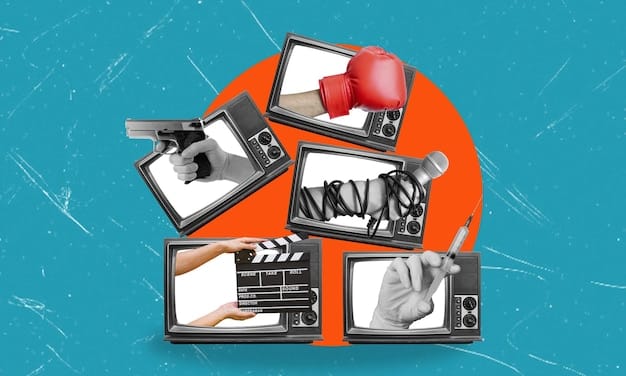Common Movie Plot Devices & Tropes: A Comprehensive Guide

Common movie plot devices and tropes are storytelling tools used repeatedly across films to create familiar and engaging narratives, often relying on audience expectations and understanding of these established conventions.
Have you ever noticed recurring patterns in movies? These aren’t coincidences but rather carefully crafted elements known as common movie plot devices and tropes. They’re the building blocks of storytelling, shaping narratives and influencing our viewing experience.
Understanding Common Movie Plot Devices and Tropes
Movie plot devices and tropes are the recurring elements that filmmakers use to create familiar and engaging narratives. They provide a shorthand for storytelling, allowing audiences to quickly grasp the situation and understand the characters’ motivations. Whether it’s a damsel in distress or a chosen one, these devices have been used for decades to craft compelling stories.
What’s the Difference Between a Plot Device and a Trope?
While often used interchangeably, plot devices and tropes have distinct meanings. A plot device is a specific element used to advance the story, like a hidden treasure map or a case of mistaken identity. A trope, on the other hand, is a more general and recurring theme or situation, such as the hero’s journey or the love triangle.
Why Are They So Popular?
These elements are popular because they resonate with audiences on a subconscious level. They tap into our shared cultural understanding of storytelling, creating a sense of familiarity and comfort. Additionally, they allow filmmakers to focus on developing characters and exploring themes without having to reinvent the wheel each time.

Here are some reasons why these devices are popular:
- They provide a foundation for storytelling, allowing filmmakers to build complex narratives on familiar structures.
- They create audience engagement by tapping into shared cultural knowledge and expectations.
- They offer a sense of predictability and comfort, which can be particularly appealing in certain genres.
In conclusion, understanding these elements is essential for appreciating the art of filmmaking. They are the tools that filmmakers use to craft compelling stories, engage audiences, and explore universal themes.
The Hero’s Journey: A Classic Trope
The hero’s journey is one of the most fundamental of common movie plot devices and tropes, and widely used story structures in cinema. This archetype outlines the transformative path a protagonist takes, typically involving a departure from their ordinary world, facing trials and challenges, and ultimately returning with newfound knowledge or power.
The Stages of the Hero’s Journey
The hero’s journey typically consists of several key stages: the ordinary world, the call to adventure, refusal of the call, meeting the mentor, crossing the threshold, tests, allies, and enemies, the approach to the inmost cave, the ordeal, the reward, the road back, the resurrection, and the return with the elixir.
Examples in Popular Movies
From Luke Skywalker in “Star Wars” to Harry Potter in the “Harry Potter” series, countless protagonists have followed the hero’s journey. These stories resonate with audiences because they reflect the universal human experience of growth, change, and self-discovery.
The hero’s journey is a powerful framework because:
- It provides a clear and compelling narrative structure.
- It allows for the exploration of complex themes, such as good versus evil, courage, and sacrifice.
- It creates relatable characters that audiences can root for.
The hero’s journey remains a cornerstone of storytelling. Its enduring appeal lies in its ability to capture the essence of human transformation and the timeless pursuit of self-discovery.
Love Conquers All: The Power of Romance
Love conquers all is a trope that is one of the most endearing of the common movie plot devices and tropes, and has become a staple in many genres. This theme suggests that love can overcome any obstacle, from societal barriers to personal flaws, leading to a happy ending.
The Appeal of Romantic Tropes
Romantic tropes, such as the “enemies to lovers” or “friends to lovers” scenarios, offer audiences a sense of hope and optimism. They tap into our innate desire for connection and the belief that love can transform lives.
Variations of the “Love Conquers All” Trope
This trope can be expressed in various ways, from romantic comedies to epic dramas. In some cases, it may involve a couple overcoming external forces, while in others, it may involve one or both partners overcoming internal struggles to be together.

Here are some popular romantic tropes:
- Enemies to lovers: Characters who initially dislike each other but eventually fall in love.
- Friends to lovers: Characters who start as friends and develop romantic feelings for each other.
- Love triangle: A situation where one character is romantically involved with two others.
In essence, the enduring appeal of love conquers all theme reaffirms our belief in the transformative power of love and the possibility of attaining happiness, even in the face of difficulty.
The Chosen One: Destiny and Special Abilities
The chosen one trope is a compelling narrative that uses the common movie plot devices and tropes. This trope centers around a protagonist who is destined to save the world or fulfill a specific prophecy, often possessing special abilities or a unique connection to the forces at play.
The Chosen One’s Journey
The chosen one’s journey often involves discovering their destiny, accepting their responsibilities, and mastering their abilities. They may face trials, tribulations, and sacrifices along the way, but their ultimate goal is to fulfill their predetermined role.
Similarities to the Hero’s Journey
The chosen one trope often overlaps with the hero’s journey, as the protagonist typically undergoes a transformative experience and emerges as a symbol of hope and inspiration.
The chosen one narrative is compelling because:
- It taps into our sense of destiny and purpose.
- It allows for the exploration of themes such as responsibility, sacrifice, and the power of belief.
- It creates a sense of excitement and anticipation as the protagonist fulfills their destiny.
Ultimately, its enduring allure lies in its capacity to ignite imagination and underscore that, in the face of overwhelming difficulty, even a singular individual can significantly alter the direction of proceedings.
Deus Ex Machina: The Unexpected Rescue
Deus ex machina, is a specific kind of common movie plot devices and tropes, translates to “god from the machine,” and refers to a plot device where a seemingly unsolvable problem is suddenly and unexpectedly resolved by an intervention, often by a new character, event, or ability.
The Origin of Deus Ex Machina
The term originated in ancient Greek drama, where a crane (the “machine”) was used to lower actors playing gods onto the stage to resolve the play’s conflict. While the device can provide a quick resolution, it is often criticized for being artificial and unsatisfying.
When Deus Ex Machina Works (and When It Doesn’t)
When used effectively, Deus ex machina can create a sense of wonder and surprise. However, when used poorly, it can feel contrived and undermine the integrity of the story. The key is to ensure that the intervention feels organic and in line with the established world and characters.
Deus ex machina can be a useful tool, but it should be used sparingly and with care:
- It can provide a quick resolution to a seemingly unsolvable problem.
- It can introduce new elements or characters to the story.
- It can create a sense of surprise and wonder.
In summary, while deus ex machina offers an avenue for swift narrative resolutions, its implementation necessitates vigilance. A lack of careful integration can compromise narrative integrity and audience engagement.
The MacGuffin: Driving the Plot Forward
The MacGuffin is a common device that employs the common movie plot devices and tropes; it’s a plot device that serves to drive the story forward. It is often an object, event, or secret that the characters are pursuing, but its specific nature is not important to the overall narrative.
Alfred Hitchcock and the MacGuffin
The term “MacGuffin” was popularized by Alfred Hitchcock, who described it as “the thing that the characters on the screen worry about, but the audience don’t care.” Hitchcock used MacGuffins in many of his films to create suspense and keep the plot moving.
Examples of MacGuffins in Movies
From the Ark of the Covenant in “Raiders of the Lost Ark” to the suitcase in “Pulp Fiction,” MacGuffins come in many forms. The key is that they provide a motivation for the characters and a focus for the plot, even if their true nature is never fully revealed.
A MacGuffin serves several purposes in a story:
- It provides a clear objective for the characters.
- It creates a sense of urgency and suspense.
- It focuses the plot and prevents it from becoming aimless.
Ultimately, even if the MacGuffin seems insignificant in itself, it serves a crucial role in compelling characters to interact and advance plotlines, keeping viewers captivated during the progression.
The Twist Ending: Surprising the Audience
The twist ending of the utilization of the key common movie plot devices and tropes, is a plot device that involves a significant and unexpected revelation at the end of a movie, completely changing the audience’s understanding of the story. It can be a powerful way to create a lasting impact and leave viewers pondering the film long after they’ve left the theater.
The Art of the Twist
A well-executed twist ending should be both surprising and logical, making sense in retrospect while still catching the audience off guard. It should be carefully foreshadowed throughout the film, with subtle clues and hints that only become clear upon the revelation.
Examples of Memorable Twist Endings
From “The Sixth Sense” to “The Usual Suspects,” some twist endings have become iconic in movie history. These films demonstrate the power of a well-executed twist to create a truly unforgettable viewing experience.
A well-crafted twist ending can:
- Surprise and delight the audience.
- Elevate the story to a new level of meaning.
- Spur discussions and interpretations among viewers.
In essence, a skillfully implemented twist has the capacity to subvert anticipations, prompting audiences to reevaluate events and storylines, thereby ensuring the movie’s resonance and enduring significance.
| Key Element | Brief Description |
|---|---|
| 🎬 Hero’s Journey | The protagonist’s transformative adventure. |
| ❤️ Love Conquers All | Love triumphs over any obstacle. |
| 🌟 The Chosen One | A destined hero with special abilities. |
| 🎁 Deus Ex Machina | Sudden, unexpected plot resolution. |
Frequently Asked Questions
▼
A plot device is a narrative technique used to move the story forward, resolve conflicts, or complicate the storyline. It can be an object, event, or character introduced solely to serve the plot.
▼
A movie trope is a commonly used theme or device. Examples include “the chosen one,” where a character is destined for greatness, or “love conquers all,” where romantic love overcomes all obstacles.
▼
Tropes and plot devices provide familiarity and structure to narratives, helping the audience quickly understand the story. They save time on exposition and allow creatives to focus on character relationships and development.
▼
Yes, a movie can rely too heavily on tropes, making it predictable and unoriginal. The most effective use of tropes involves subversion or combining them in novel ways to surprise and delight audiences.
▼
Plot devices and tropes, when used effectively, can enrich storytelling by adding layers of meaning, creating emotional resonance, and providing a shared cultural language between filmmakers and those with whom such films resonate most.
Conclusion
Understanding common movie plot devices and tropes enriches our appreciation of filmmaking. These techniques are fundamental in shaping compelling narratives, engaging audiences, and exploring timeless themes. Recognizing these elements allows us to delve deeper into the art of storytelling and see movies in a new light.





